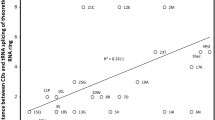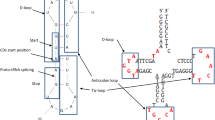Abstract
A comparison is made among all the models proposed to explain the origin of the tRNA molecule. The conclusion reached is that, for the model predicting that the tRNA molecule originated after the assembly of two hairpin-like structures, molecular fossils have been found in the half-genes of the tRNAs of Nanoarchaeum equitans. These might be the witnesses of the transition stage predicted by the model through which the evolution of the tRNA molecule passed, thus providing considerable corroboration for this model.










Similar content being viewed by others
References
Bloch DP, McArthur B, Mirrop S (1985) tRNA-rRNA sequence omologies: evidence from an ancient modular format shared by tRNAs and rRNAs. BioSystems 17:209–225
Darnell JE Jr (1978) Implications of RNA-RNA splicing in evolution of eukaryotic cells. Science 202:1250–1260
de Duve C (1988) The second genetic code. Nature 33:117–118
Demongeot J, Moreira A (2007) A possible circular RNA at the origin of life. J Theor Biol 249:314–324
Dick TP, Schamel WA (1995) Molecular evolution of transfer RNA from two precursor hairpins: implications for the origin of protein synthesis. J Mol Evol 41:1–9
Di Giulio M (1992) On the origin of the transfer RNA molecule. J Theor Biol 159:199–214
Di Giulio M (1994) On the origin of proteins synthesis: a speculative model based on hairpin RNA structures. J Theor Biol 171:303–308
Di Giulio M (1995) Was it an ancient gene codifyng for a hairpin RNA that, by means of direct duplication, gave rise to the primitive tRNA molecule? J Theor Biol 177:95–101
Di Giulio M (1999) The non-monophyletic origin of tRNA molecule. J Theor Biol 197:403–414
Di Giulio M (2002) Genetic code origin: Are the pathways of the type Glu-tRNAGln->Gln-tRNAGln molecular fossils or not? J Mol Evol 55:616–622
Di Giulio M (2004) The origin of the tRNA molecule: implications for the origin of protein synthesis. J Theor Biol 226:89–93
Di Giulio M (2006a) The non-monophyletic origin of the tRNA molecule and the origin of genes only after the evolutionary stage of the Last Universal Common Ancestor (LUCA). J Theor Biol 240:343–352
Di Giulio M (2006b) Nanoarchaeum equitans is a living fossil. J Theor Biol 242:257–260
Di Giulio M (2008a) Permuted tRNA genes of Cyanidioschyzon merolae, the origin of the tRNA molecule and the root of the Eukarya domain. J Theor Biol 253:587–592
Di Giulio M (2008b) Split genes, ancestral genes. In: Tze-Fei Wong J, Lazcano A (eds) Prebiotic evolution and astrobiology, chap 13. Landes Bioscience, Austin, TX
Doolittle WF (1978) Genes in pieces: were they ever together? Nature 272:581–582
Eigen M, Winkler-Oswatitsch R (1981) Transfer-RNA, an early gene? Naturwissenschaften 68:282–292
Fujishima K, Sugahara J, Tomita M, Kanai A (2008) Sequence evidence in the archaeal genomes that tRNAs emerged through the combination of ancestral genes as 5′ and 3′ tRNA halves. PLoS ONE 3(2):e1622
Gilbert W (1978) Why genes in pieces? Nature 271:501
Hopfield JJ (1978) Origin of the genetic code: a testable hypothesis based on tRNA structure, sequence and kinetic proofreading. Proc Natl Acad Sci USA 75:4334–4338
Maizels N, Weiner AM (1993) The genomic tag hypothesis: modern viruses as molecular fossils of ancient strategies for genomic replication. In: Gesteland RF, Atkins JF (eds) The RNA world. Cold Spring Harbor Laboratory Press, Plainview, NY, pp 577–602
Maizels N, Weiner AM (1994) Phylogeny from function: evidence from the molecular fossil record that tRNA originated in replication, not translation. Proc Natl Acad Sci USA 91:6729–6734
Moller W, Janssen GMC (1990) Transfer RNAs for primordial amino acids contains remnants of a primitive code at position 3 to 5. Biochimie 72:361–368
Moller W, Janssen GMC (1992) Statistical evidence for remnants of primordial code in the acceptor stem of prokaryotic transfer RNA. J Mol Evol 34:471–477
Nazarea AD, Bloch DP, Semrau AC (1985) Detection of a fundamental modular format common to transfer and ribosomal RNAs. Proc Natl Acad Sci USA 82:5337–5341
Orgel LE (1968) Evolution of the genetic apparatus. J Mol Biol 38:381–383
Randau L, Munch R, Hohn M, Jahn D, Soll D (2005) Nanoarchaeum equitans creates functional tRNAs from separate genes for their 5′- and 3′-halves. Nature 433:537–541
Randau L, Soll D (2008) Transfer RNA genes in pieces. EMBO Rep 9:623–628
Rodin S, Rodin A (2006) Origin of the genetic code: first aminoacyl-tRNA synthetases could replace isofunctional ribozymes when only the second base of codons was established. DNA Cell Biol 25:365–375
Rodin S, Ohno S, Rodin A (1993) Transfer RNA with complementary anticodon: could they reflect early evolution of discrimative genetic code adaptors? Proc Natl Acad Sci USA 90:4723–4727
Rodin S, Rodin A, Ohno S (1996) The presence of codon-anticodon pairs in the acceptor stem of tRNAs. Proc Natl Acad Sci USA 93:4537–4542
Schimmel P, Giege R, Morras D, Yokoyama S (1993) An operational RNA code for amino acids and possible relationship to genetic code. Proc Natl Acad Sci USA 90:8763–8768
Schimmel P, Ribas de Pouplana L (1995) Transfer RNA: from minihelix to genetic code. Cell 81:983–986
Soma A, Onodera A, Sugahara J, Kanai A, Yachie N, Tomita M, Kawamura F, Sekine Y (2007) Permuted tRNA genes expressed via a circular RNA intermediate in Cyanidioschyzon merolae. Science 318:450–453
Sun FJ, Caetano-Anolles G (2008) The origin and evolution of tRNA inferred from phylogenetic analysis of structure. J Mol Evol 66:21–35
Tanaka T, Kikuchi Y (2001) Origin of cloverleaf of transfer RNA—the double-hairpin model: implication for the role of tRNA intron and the long extra loop. Viva Origino 29:134–142
Widmann J, Di Giulio M, Yarus M, Knight R (2005) tRNA creation by hairpin duplication. J Mol Evol 61:524–530
Woese CR (1969) The biological significance of the genetic code. Prog Mol Subcell Biol 1:5–46
Wong JT (1975) A co-evolution theory of the genetic code. Proc Natl Acad Sci USA 72:1909–1912
Yuan J, Shepperd K, Soll D (2008) Amoni acid modifications on tRNA. Acta Biochim Biophys Sin 40:539–553
Author information
Authors and Affiliations
Corresponding author
Rights and permissions
About this article
Cite this article
Di Giulio, M. A Comparison Among the Models Proposed to Explain the Origin of the tRNA Molecule: A Synthesis. J Mol Evol 69, 1–9 (2009). https://doi.org/10.1007/s00239-009-9248-z
Received:
Revised:
Accepted:
Published:
Issue Date:
DOI: https://doi.org/10.1007/s00239-009-9248-z




